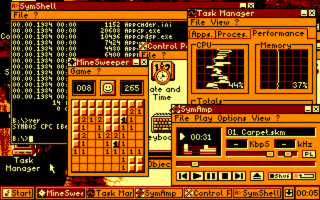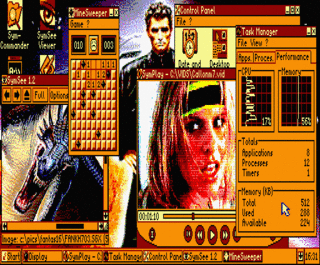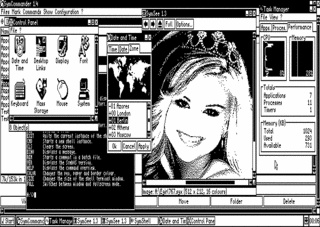Parts of this article have been copied from the english Wikipedia article.
SymbOS is a free multitasking operating system for Z80 based 8-bit computer systems written by Prodatron. At present it is available for the computers of the Amstrad CPC as well as for all MSX models starting from the MSX2 standard and all Amstrad PCW (Joyce) models until the PcW10. Contrary to early 8-bit operating systems it is based on a microkernel, which provides pre-emptive and priority oriented multitasking and manages RAM memory with a size of up to 1024 kB. SymbOS contains a MS-Windows like GUI, supports hard discs with a capacity of up to 128 GB and can already be booted on an unexpanded Amstrad CPC-6128, PCW or a 128K-MSX2.
History
Already in the 80's, only few years after the release of the Commodore C64, the legendary GEOS by Berkeley Softworks appeared and set the standard for a windows-based operating system on c64. It was a graphical user-interface (GUI) which was similar to the old desktop of the Apple Macintosh. Powerfull applications were made available for GEOS like GeoWrite (similar to MS-Word) or GeoCalc (similar to MS-Excel). It was incredible, that an 8bit-machine with only 64K was able to realize such an operating system.
On the Amstrad CPC many efforts to build a decent GUI were made as well. In most cases they were just extensions to realize a WIMP (Windows, Icons, Menus and Pointers) environment but weren't true operating systems with their own kernel, memory-management and so on. Examples of such extension-systems are, Max, Mos, Geno, Stream2, Ceus-Desktop and others.
Therefore, the CPC's own OS (in combination with AmsDOS) and CP/M were the only two known OSes for the series, but the question remained: since most CPCs have 128K (most C64 only have 64K), a screen-resolution of 320x200 with 4 colours (C64 only has 2 colours for each 8x8 area in 320x200) and some more advantages, why not have something similar? So the SymbOS-Project was born. SymbOS stands for "SYmbiosis Multitasking Based Operating System". SymbOS is a demonstration of what has been achieved on the CPC: real preemptive multitasking, dynamic memory-management for up to 1024K and a totaly MS-Windows-like GUI are the three most important features.
Events
The following is a list of important events during the SymbOS development.
- 11/2000: Development started
- 06/2001: First preview of the desktop on the CPC Reunion 1
- 07/2001: First screen shots in the internet, causing several rumours about a possible hoax
- 06/2002: Second preview of the desktop on the CPC Reunion 2
- 09/2004: SymbOS development has been continued after a break of three years
- 12/2004: Full CPC IDE support implemented; preview of a harddisc based movie player, which used the SymbOS IDE/FAT routines
- 01/2005: Release of the first official preview on the SymbOS Preview party
- 09/2005: SymbOS development has been continued again
- 12/2005: Full SYMBiFACE II support implemented
- 01/2006: SymbOS is part of the CPC TREX startup system now
- 04/2006: SymbOS release 1.0 is out
- 05/2006: Development of the MSX version started
- 12/2006: SymbOS release 1.1 is out
- 05/2007: 1 MB RAM and rich-text support together with the graphical browser SymZilla have been implemented
- 07/2007: Development of the PCW version started
- 08/2007: SymbOS release 2.0 is out
Technical background
The Z80 8-bit CPU is able to run a pre-emptive multitasking environment. The MP/M operating system already proved, that multitasking on Z80 computers is possible.
The existance of an alternative register set accelerates the content switching between the tasks dramatically. The restriction of Z80 systems to a 64 kB address space can be solved with bank switching. In this way computers like the Amstrad CPC and PCW, MSX, Enterprise or SAM Coupé are able to access hundred or thousand of kilobytes of memory.
Feature overview
- Micro kernel
- Maximum amount of supported RAM: 1024 KB
- Maximum number of processes: 32
- Number of different process priorities: 9
- Maximum number of timers: 32
- Maximum number of open messages: 64
- System manager
- Maximum number of applications: 24
- Maximum application core size: 63 KB
- Desktop manager
- Maximum number of windows: 32
- Maximum number of controls per window: 1000
- Maximum possible screen resolution: 16.000 x 16.000 pixel
- File manager
- Maximum hard disc size: 128 GB
- Maximum file size: 2 GB
- Maximum number of devices: 8
- Maximum number of open files: 7
- Source code
- Source code size (OS Release 2): ~ 44.000 lines (1,3MB)
- Source code size (Applications): ~ 48.000 lines (2,0MB)
- Total size of the Z80 source code: ~ 92.000 lines (3.3MB)
- Supported platforms
- Supported external hardware
- dk'tronics memory expansion 64K-512K and compatibles (Dobbertin, SYMBiFACE II)
- SYMBiFACE II (realtime clock, only in binary mode; PS/2 mouse; IDE interface)
- AMX and Kempston mouse (PCW)
- Sunrise IDE interface (MSX)
Kernel
SymbOS includes a micro kernel, which takes over the fundamental tasks of an operating system. They are subdivided into the task management, the memory management, the banking management and the messaging.
Task management
For the task management a combination of pre-emptive and cooperative multitasking has been choosed, which makes different task priorities possible. Pre-emptive means that tasks are interrupted after a certain amount of time by the operating system, in order to share the CPU time with other tasks. Cooperatively means, that a task stops using CPU time by itself. It does it, if it finished its current job or is waiting for a certain event. Because of this combination it is possible to assign priorities. Tasks with a low priority receive CPU time only if all tasks with higher priorities are not currently working.
Memory and banking management
The memory management divides the entire RAM into small 256 byte blocks, which can be assigned dynamically. Applications are always running in a secondary 64 kB RAM bank, where no memory space is occupied by the operating system or the video memory. That makes it possible to reserve up to 63 kB in one piece.
The banking management makes sure, that the system is able to administer memory with a size of one megabyte even with the fact that the Z80 CPU has only a 16-bit address bus. It makes transparent access to memory and functions placed in other 64 kB banks possible.
Messaging
The communication between different tasks and the operating system usually does not take place via "Calls", but is done via "Messages". This is necessarily inside a multitasking environment to avoid organisation problems with the stack, global variables and shared system resources.
Graphical user interface
The GUI of SymbOS works completely object-oriented. Regarding the look and feel it is designed like MS windows. It contains the well-known task bar with the clock and the "start" menu and can open a big amount of windows, which can be shifted, resized and scrolled. As the complete system is written in optimized assembler, the speed of the GUI is only insignificantly under this of current systems and even faster than the original Amiga workbench.
The complete content of a window is defined with "controls". These are e.g. slider, check boxes, text lines, buttons or graphics. The background or not visible areas of a window don't need to be saved in a bit-map buffer. If an area is restored on the display, its content will just be redrawed. Because of this the SymbOS GUI works much more memory-friendlier than most other 8-bit GUIs.
File system management
SymbOS supports the file systems CP/M, AMSDOS, FAT12, FAT16 and FAT32 on all platforms. With the last one SymbOS is able to address mass storage devices with a capacity of up to 128 GB. Also the ability to administer files with a size of up to 2 GB is uncommon for an 8-bit system. Because of the FAT support data exchange with other computers is quite easy, as most 32 and 64 bit operating systems do support the three FAT file systems.
Applications and executables
There are several standard applications available for SymbOS, which have beend designed as clones of well known Windows and Macintosh programs. As an example these are applications similar to the Norton Commander (SymCommander), QuickTime (SymPlay), WinAmp (SymAmp) or Minesweeper.
- Applications
- SymCommander (file and disc management)
- SymZilla (browser and richtext viewer)
- SymPlay (video player)
- SymSee (picture viewer)
- SymAmp (jukebox music player)
- Tools
- SymSnap (emulator snapshot loader)
- DiskDeDumper (image to disc transfer)
- Pocket Calculator (calculator)
- SYMBiFACE II rom manager (rom management for the SYMBiFACE II)
- Games
- Pac-Man for SymbOS (game)
- MineSweeper (game)
- Demos and Screensavers
- Diamonds (demo)
- Starfield Simulation (screensavers)
- System programs
- Control Panel (system configuration)
- Task Manager (system monitor)
- SymShell (command line interface)
SymStudio
SymStudio is a Windows-based IDE (integrated development environment) by Trebmint for SymbOS similiar to MS Visual Studio. SymStudio makes it possible to develop SymbOS applications in Assembler or Basic ("SymBasic"). It is also possible to convert PC graphics and videos into the SymbOS format (SGX, VID). Have a look at its article for more information. Currently there is only a beta version available.
Porting and cross platform ability
SymbOS has been developed originally for the Amstrad CPC. Because of the modular structure with the strict separation of general and hardware components the porting to other Z80-based systems is quite easy.
The MSX computers starting with the MSX2 standard are supported since summer 2006. The Amstrad PCW port is available since August 2007. Versions for the Enterprise 128 and the SAM Coupé are possible, too, as they fulfill the requirements for SymbOS.
By keeping a basic condition for an operating system, the strict separation of hardware and application software by the supply of an intermediate layer, SymbOS applications run platform-independently on each computer and do not have to be adapted for a special system. Exceptions are applications, which access directly the hardware.
Motivation
SymbOS was originally started as an experiment to find out, how far it is possible to implement a multitasking based operating system with a windows GUI on an 8-bit computer of 1985. Also GEOS contributed to the motivation, but the structure and features of SymbOS aren't similiar to this system. The release in 2006 proved, that such a "mini windows" is possible on a 20 years old home computer only with quantitative limitations. SymbOS is one of the largest retro computing software projects of the last years. One of the goals of the project is to copy in combination with various hardware extensions a complete PC job.
Web links
- SymbOS homepage
- SymbOS mailing list (new)
- english Wikipedia article
- spanish Wikipedia article
- italian Wikipedia article
- russian Wikipedia article
- french information on CPCRulez
- "New Generation - CPC Windows?" (WACCI article by ChaRleyTroniC)
- "8-Bit GUIs - Eye candy’s not just for the 32-bit!" (Article)
- Main thread on MSX.org
- SymbOS presentation(Video) at RetroEuskal 2006


